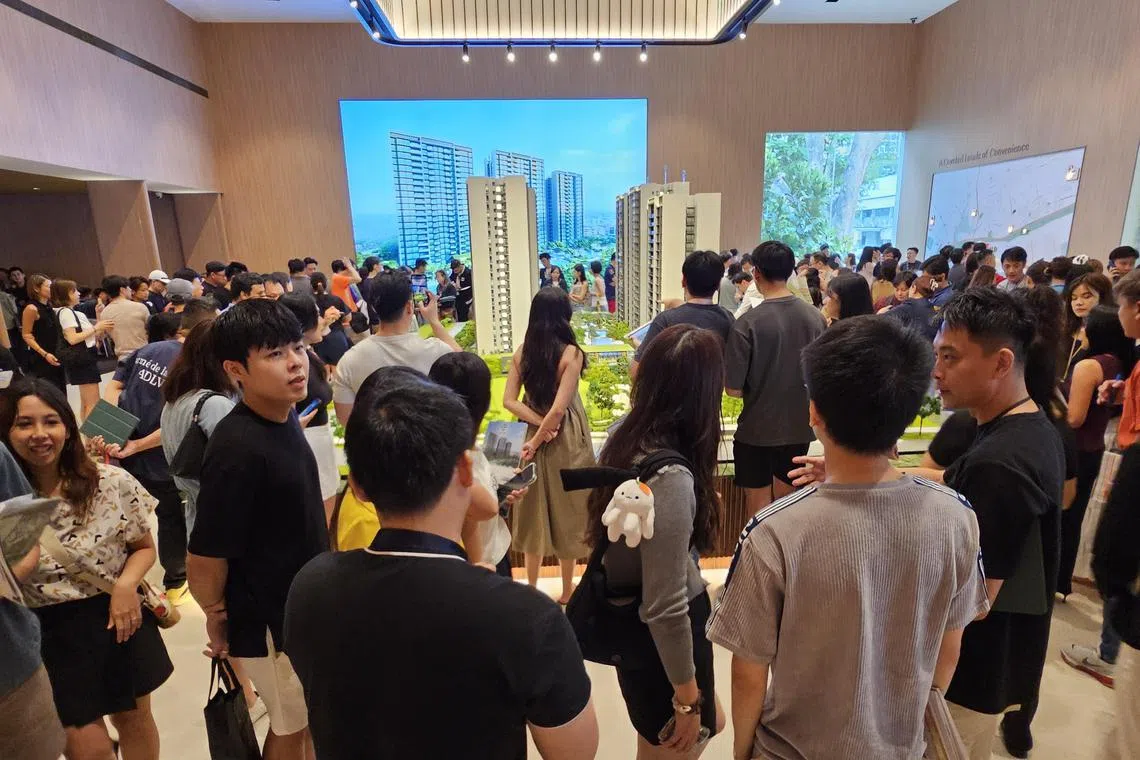Condo sizes shrank in past 15 years as developers sought to keep prices manageable
Sign up now: Get ST's newsletters delivered to your inbox

Islandwide, the median size of non-landed new condos has dropped 10.6 per cent to 904 sq ft in 2024 from 1,012 sq ft in 2010.
PHOTO: SIM LIAN GROUP
Follow topic:
SINGAPORE – Event organiser Jane Seet bought a 678 sq ft two-bedder in Emerald of Katong in November 2024 for $1.84 million, but has no plans to live in it because it is too small.
Instead, Ms Seet, 39, who is residing in a 1,700 sq ft terraced house with her husband, a 42-year-old tech trainer, intends to either flip the condominium unit once it receives its temporary occupation permit or rent it out.
“The long-term goal is for us to own one property each. Ideally, I would have wanted to buy a three-bedder. But that would have cost $2.5 million. I chose the two-bedder because I am not living in it,” she said. The couple have no children.
New condos have become smaller in the past 15 years, a trend that analysts attributed to developers turning to “bite-sized” units following loan curbs, several rounds of property cooling measures and changing demographic needs.
Analysts say this effectively meant that developers would push out smaller units to keep the absolute price quantums at levels that buyers could stomach, as private residential property prices surged 76.9 per cent cumulatively from 2010 to 2024. This has resulted in higher per sq ft (psf) prices.
Islandwide, the median size of non-landed new condos has dropped 10.6 per cent to 904 sq ft in 2024 from 1,012 sq ft in 2010, according to Cushman & Wakefield, which collated data for The Straits Times based on the median size of new home transactions in the past 15 years.
In this period, the decrease in the median floor areas of new condos in the prime district outpaced that in the suburban and city fringe sub-markets. The median floor areas of new prime condos dropped 20.6 per cent to 829 sq ft in 2024 from 1,044 sq ft in 2010.
In comparison, the median floor areas of new suburban condos shed 13.4 per cent to 904 sq ft from 1,044 sq ft, while new city fringe condos saw a 4.5 per cent drop in median unit sizes to 904 sq ft from 947 sq ft.
Cushman & Wakefield research head Wong Xian Yang noted that the drop in the median floor areas for new executive condominiums is less pronounced compared with that of new condos because most exec condos are purchased by owner-occupiers and families requiring larger living spaces, rather than for investment purposes.
New exec condo unit sizes fell 8.1 per cent to 980 sq ft in 2024 from 1,066 sq ft in 2010, and were down 2.2 per cent from 1,001 sq ft in 2023.
ERA Singapore chief executive Marcus Chu noted that the space reductions were mostly in kitchen, living and dining areas, which are increasingly designed for interchangeable use.
“Even though some developments have smaller kitchens, living and dining areas, their layout is designed to overlap, allowing for flexible and interchangeable use. For instance, the kitchen space can be converted into dining space, should they require more space for hosting,” Mr Chu said.
The average size of homes decreased most significantly between 2014 and 2018, as small-format homes became popular with investors.
But after several rounds of hikes in the additional buyer’s stamp duty since 2018, the number of investors declined, and more buyers began buying larger homes for their own occupancy, OrangeTee chief researcher and strategist Christine Sun said.
“Investors realised that two-bedroom units are easier to lease than one-bedroom units, leading to a further drop in demand for one-bedders,” she added.
Over the years, the authorities have implemented measures to ensure that private homes do not get too small.
In 2012 and 2019, the Urban Redevelopment Authority (URA) introduced guidelines to set a maximum number of units in a non-landed residential project. This was to ensure that private residential units do not get unreasonably small, and to moderate the percentage of the smallest and largest units in proportion to the total number of units in a project, noted Ms Dora Chng, GuocoLand’s residential director.
Also in 2019, the authorities reduced developers’ balcony bonus gross floor area incentives from 10 per cent to 7 per cent, and mandated that balconies could not exceed 15 per cent of the net internal area of units – a measure aimed at maximising liveable space in new units, said analysts.
The net internal area refers to the net living space of a unit, which excludes voids, balconies, air-conditioner ledges and other external areas.
For all new projects in the central area, URA also stipulated that from Jan 18, 2023, the developments must ensure that at least 20 per cent of dwelling units have a net internal area of at least 70 sq m.
This size is considered “reasonable” for small families, taking into account the tighter space constraints of the central area, URA said.
These measures appear to have worked. According to OrangeTee, sales of new shoebox units slumped to 254 in 2024, down 90.6 per cent from a peak of 2,709 units in 2012.
The latest effort to ensure that private homes remain liveable came in the form of new rules on the harmonisation of floor-area definitions that took effect on June 1, 2023, requiring all strata areas to be computed as gross floor area (GFA).
Previously, elements such as private air-con ledges were excluded from the GFA computation, meaning they did not count towards the maximum allowable floor area of a condo project if they fulfilled certain requirements, and would therefore count as “free area” for developers.
But under the new harmonised floor area regime, if a developer wants to count private air-con ledges as saleable floor area, these ledges will be computed as GFA. In other words, these spaces will no longer be free to developers. They will then be incentivised to build smaller air-con ledges and more liveable space for home owners.
This is to ensure that developers build a product that reflects what home buyers need, rather than what maximises developers’ revenues, said Mr Edwin Loo, an associate director at real estate consultancy Cistri and a former urban planning team lead at URA.
“But just because units are getting smaller doesn’t mean that liveability is compromised,” he pointed out.
“We need to distinguish between the strata or saleable area as shown on the plan, and liveable space, or the net internal area of the unit.”

For example, a 1,000 sq ft unit with oversized balconies, multiple bay windows and an oversized air-con ledge will most likely feel less spacious and functional compared with a 900 sq ft unit designed to maximise net internal area, Mr Loo said.
While URA’s measures in 2012 and 2019 were good first steps in addressing these issues, Mr Loo added that, increasingly, more measures to curb the drop in the median sizes of condos will be critical.
This is because the rising prices of large HDB resale flats in good locations in recent years are due partly to “an absence of new private condos that offer a reasonable balance between price and liveable space”, he noted.
“Buyers who are more likely to switch to the private market may be holding off as they see more value and space in the HDB resale market,” he added.
Grace Leong is senior correspondent at The Straits Times, covering property, white-collar crime, bankruptcies and liquidation.


